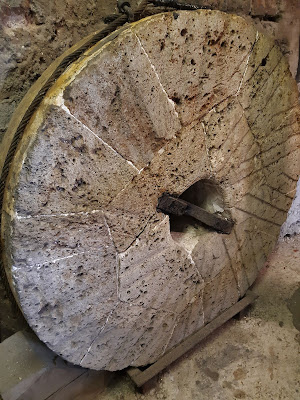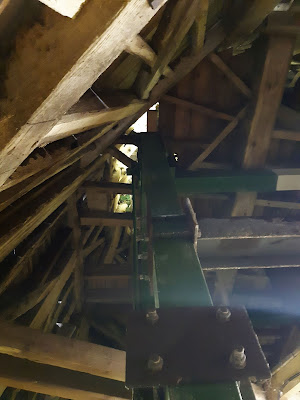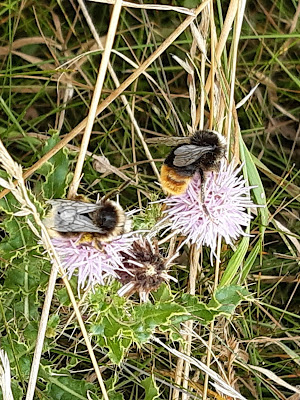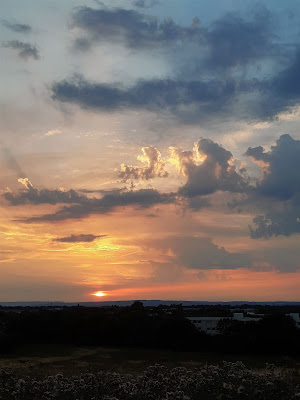And of course it's been hot this summer, and a lot drier than usual. The deserted farmland is tinder dry, although a few flowers are regenerating after the mowing it received early last month.
Meanwhile in the field of the hollowing oak, big cracks have appeared in the path that goes around the perimeter ...
... though the most marked indication of drought is on the the golf course, by the small pond. It's possible, with a little art, to take photos that make it look as it quite normal, as we make occasional illicit trips past it at twilight when all the golfers have left for home ...
... but actually, it's level is low enough to reveal all sorts of horrors under the surface, to go alongside detritus left by the (also illicit) evening fishermen.
The larger, shallower pond is no more than damp at present, but that's nothing unusual. It's full of loosestrife, common mint, ragwort, fleabane, thistle, and reedmace.
It's also the season for feather shedding, though for some reason this summer, I've found only corvid feathers. (Not that I'm complaining because they're beautiful.) I did decide at one point not to pick any more up, as I've enough to reconstruct several murders, but I can't seem to help myself. Here's some of the latest batch.
My favourite is the last one. I think it's the tail feather of a magpie, and it's very notched and battered, having been on so many adventures.
As usual, the untended parts of Elsewhere are more diverse than the tended areas, although even up the field and on the path by the embankment there are fewer flowers and insects now. Nevertheless, there's still something new and interesting to see every time we go there.
Gradually over the month all this has set or started to set seed ... thistles, vetch, bindweed, agrimony, yarrow, hemp agrimony, melilot, greater burnet saxifrage, fleabane and common mint, tansy, betony, and great or hairy willowherb, with outliers and the woody nightshade still going strong.
The thistledown is still omnipresent, but it's startlingly thick every year. It lines the narrow badger path near the bottom of the field and makes it even harder to see the tunnels and scrapes undermining it.
Still ebullient are my favourite wild carrots, which line long sections of the footpath.
They look like they've been designed by someone with a spirograph and fade from perfect parasols to snowflakes to mad hats.
Referencing their other name of Queen Anne's Lace, I've never seen one with such a pronounced blood spot as this before.
As for insects, there are rather more bees than butterflies around now, and definitely no more red soldier beetles.
There's a mix here of buff-tailed bumbles, Common Carders, a honey bee, gatekeepers, a speckled wood, and a skipper on a very busy yarrow also accommodating a house fly and something I can't identify that's in the process of landing.
At the bottom of the field, the Small Dark Wood of the Mind is still quite dark, and appears to have some sort of a portal thing going on. The Grove of the Silver Chair and Ruby Crown remain largely unchanged.
an owl pellet: its rather pointed ends suggest it might be from a tawny owl
Meanwhile, down on the path by the railway embankment, the profusion of vegetation that made us forget this will soon be a building site has started to die back, so that you can now just see
the nasty plastic fence that was put up in March, while the now ghostly rosebay willowherb stands by the fence and choruses a warning.
Out on the farmland there have been strange patterns in the sky ...
... and the areas that did escape the scythe earlier now remind me of my Auntie Betty's carpet in the 1970s.
It's definitely beginning to look autumnal out there ...
... with a not-too-distant harvest of blackberries and sloes (guarded by stingers), apples, damsons and elderberries.
The rookery is largely silent now, though we did see rabbits on the soon-to-be pitch and putt again, and out on the fields, we had a couple of encounters with a family of three roe deer. I'd seen one earlier this summer in the hedgerow where the damsons and apples are, but one night when we were down there, we saw them emerge and bound across the field, pursued in a thankfully half-hearted fashion by a curious rather than murderous Cwtch. (Ted probably would have been murderous, though he'd never have caught them either.)
Just a week later a chopsy Jack Russell drove them out of the same hedge before being put firmly back on the lead. Cwtch just contented herself with a little growl (once everyone was out of earshot).
Finally, sunsets - occasionally out on the farmland ...
... but more usually up the field, with its oak and its view of Avonmouth and the hills of Wales. Always a good end to even the hottest day, although its progress along the tops towards the estuary shows how we're heading towards winter.
 The sun in competition with the windows of the Mall at Cribbs Causeway
The sun in competition with the windows of the Mall at Cribbs Causeway





































































